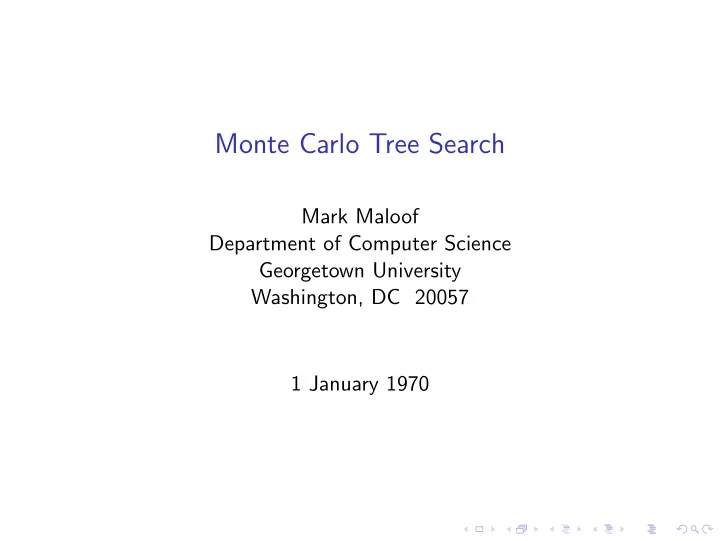

Monte Carlo Tree Search Mark Maloof Department of Computer Science Georgetown University Washington, DC 20057 1 January 1970
Overview ◮ MCTS consists of four main steps (Browne et al., 2012) 1. Selection: Starting at the root, select the best action until reaching a node that has not been fully explored (i.e., a node with untried and therefore unevaluated actions). 2. Expansion: Choose an action, and expand the tree by adding a child node. 3. Simulation: From the newly added child, uniformly randomly select actions until reaching a leaf node and receiving a reward (e.g., +1 for winning, − 1 for losing). 4. Backpropagation: Starting at the new child node, propagate the reward to the root by adjusting the visit count N ( v ) and the simulation reward Q ( v ) of the nodes along the path.
Figure 2, Brown et al. (2012)
Upper-confidence Bound for Trees (UCT) 1: function uctSearch( s 0 ) create a root node v 0 with state s 0 2: while within computational budget do 3: v l ← treePolicy( v 0 ) 4: ∆ ← defaultPolicy(( s ( v l )) 5: backup( v l , ∆) 6: end while 7: return a (bestChild( v 0 , 0)) 8: 9: end function
Tree Policy 1: function treePolicy( v ) while v is non-terminal do 2: if v not fully expanded then 3: return expand( v ) 4: else 5: v ← bestChild( v , C p ) 6: end if 7: end while 8: return v 9: 10: end function
Expand 1: function expand( v ) choose a ∈ untried actions from A ( s ( v )) 2: add a new child v ′ to v with s ( v ′ ) = f ( s ( v ) , a ) and 3: a ( v ′ ) = a return v ′ 4: 5: end function
Best Child 1: function bestChild( v , c ) � Q ( v ′ ) 2 ln N ( v ) return argmax v ′ ∈ Children ( v ) N ( v ′ ) + c 2: N ( v ′ ) 3: end function
Default Policy 1: function defaultPolicy( s ) while s is non-terminal do 2: choose a ∈ A ( s ) uniformly at random 3: s ← f ( s , a ) 4: end while 5: return reward for state s 6: 7: end function
Backup 1: function backup( v , ∆) while s is not null do 2: N ( v ) ← N ( v ) + 1 3: Q ( v ) ← Q ( v ) + ∆( v , p ) ⊲ p is player 4: v ← parent of v 5: end while 6: 7: end function
Backup Negamax 1: function backupNegamax( v , ∆) while s is not null do 2: N ( v ) ← N ( v ) + 1 3: Q ( v ) ← Q ( v ) + ∆ 4: ∆ ← − ∆ 5: v ← parent of v 6: end while 7: 8: end function
Figure 3, Brown et al. (2012)
Monte Carlo Tree Search Mark Maloof Department of Computer Science Georgetown University Washington, DC 20057 1 January 1970
References I C. Browne, E. Powley, D. Whitehouse, S. Lucas, P. I. Cowling, P. Fohlfshagen, S. Tavener, D. Perez, S. Samothrakis, and S. Colton. A survey of Monte Carlo tree search methods. IEEE Transactions on Computational Intelligence and AI in Games , 4(1):1–43, 2012. doi: 10.1109/TCIAIG.2012.2186810 .
Recommend
More recommend